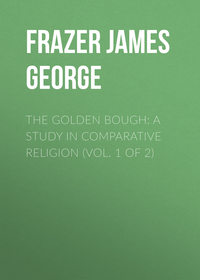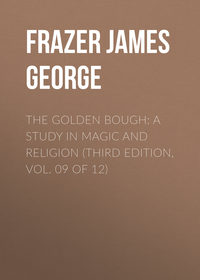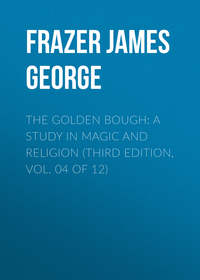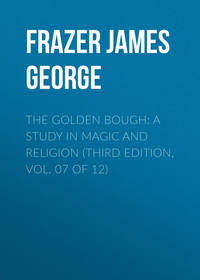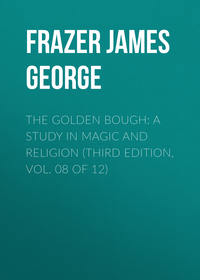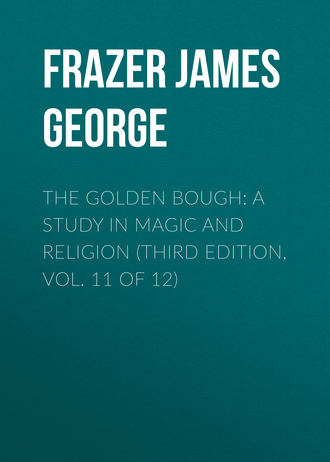
The Golden Bough: A Study in Magic and Religion (Third Edition, Vol. 11 of 12)
754
W. Warde Fowler, “The Oak and the Thunder-god,” Archiv für Religionswissenschaft, xvi. (1913) pp. 317-320.
755
The Magic Art and the Evolution of Kings, ii. 356 sqq.
756
The suggestion is Mr. W. Warde Fowler's (op cit. pp. 319 sq.).
757
Pliny, Natur. Hist. xvi. 249.
758
See above, p. 85.
759
J. Grimm, Deutsche Mythologie,4 i. 153. See above, p. 85.
760
This interpretation of Balder's death was anticipated by W. Schwartz (Der Ursprung der Mythologie, Berlin, 1860, p. 176), who cut the whole knot by dubbing Balder “the German thunder-and-lightning god” and mistletoe “the wonderful thunder-and-lightning flower.” But as this learned writer nursed a fatal passion for thunder and lightning, which he detected lurking in the most unlikely places, we need not wonder that he occasionally found it in places where there were some slight grounds for thinking that it really existed.
761
On the relation of the priest to Jupiter, and the equivalence of Jupiter and Juno to Janus (Dianus) and Diana, see The Magic Art and the Evolution of Kings, ii. 376 sqq.
762
“I quite agree how humiliating the slow progress of man is, but every one has his own pet horror, and this slow progress or even personal annihilation sinks in my mind into insignificance compared with the idea or rather I presume certainty of the sun some day cooling and we all freezing. To think of the progress of millions of years, with every continent swarming with good and enlightened men, all ending in this, and with probably no fresh start until this our planetary system has been again converted into red-hot gas. Sic transit gloria mundi, with a vengeance” (More Letters of Charles Darwin, edited by Francis Darwin, London, 1903, i. 260 sq.).
763
Since this passage was written the hope which it expresses has been to some extent strengthened by the discovery of radium, which appears to prolong indefinitely the prospect of the duration of the sun's heat, and with it the duration of life on its attendant planets. See (Sir) George Howard Darwin's Presidential Address to the British Association, Report of the 75th Meeting of the British Association for the Advancement of Science (South Africa, 1905), pp. 28 sq.; F. Soddy, The Interpretation of Radium, Third Edition (London, 1912), pp. 240 sqq.; E. Rutherford, Radio-active Substances and their Radiations (Cambridge, 1913), pp. 653-656. At the same time it should be borne in mind that even if the atomic disintegration and accompanying liberation of energy, which characterize radium and kindred elements, should prove to be common in different degrees to all the other elements and to form a vast and till lately unsuspected store of heat to the sun, this enormous reserve of fuel would only defer but could not avert that final catastrophe with which the solar system and indeed the whole universe is remorselessly threatened by the law of the dissipation of energy.
764
See above, vol. i. pp. 15 sq.
765
Alexander Carmichael, Carmina Gadelica, Hymns and Incantations with Illustrative Notes on Words, Rites, and Customs, dying and obsolete: orally collected in the Highlands and Islands of Scotland and translated into English (Edinburgh, 1900), ii. 312.
766
Above, vol. i. pp. 315 sqq.
767
The late Rev. P. Dehon, S.J., “Religion and Customs of the Uraons,” Memoirs of the Asiatic Society of Bengal, vol. i. No. 9 (Calcutta, 1906), p. 141.
768
“Every clan (Familienstamm) has a definite thing which is forbidden to all the members of the clan, whether it be a particular kind of meat, or a certain fish, or as here the stalk of a gourd.”
769
“The place in Nguu, where the ghost is said to dwell.”
770
“In Ukami.”
771
C. Velten, Schilderungen der Suaheli (Göttingen, 1901), pp. 195-197.
772
Miss Alice Werner, The Natives of British Central Africa (London, 1906), p. 82. In a letter Miss Werner tells me that she learned these particulars at Blantyre in 1893, and that the chief lived in the neighbourhood of Mlanje.
773
Rev. Henry Rowley, Twenty Years in Central Africa (London, N.D.), pp. 36 sqq. For a reference to this and all the other works cited in this Note I am indebted to the kindness of Miss Alice Werner.
774
Rev. David Clement Scott, A Cyclopaedic Dictionary of the Mang'anja Language spoken in British Central Africa (Edinburgh, 1892), p. 315.
775
Edward Steere, Swahili Tales (London, 1870), pp. 441-453. The young man in the story is spoken of now as the nephew and now as the son of the man he murdered. Probably he was what we should call a nephew or brother's son of his victim; for under the classificatory system of relationship, which seems to prevail among the Bantu stock, to whom the Swahili belong, a man regularly calls his paternal uncle his father.
776
Above, vol. i. pp. 104 sq.
777
Virgil, Aen. vi. 205 sqq.: —
“Quale solet silvis brumali frigore viscumFronde virere nova, quod non sua seminat arbos,Et croceo fetu teretis circumdare truncos:Talis erat species auri frondentis opacaIlice,sic leni crepitabat bractea vento.”778
W. Schlich, Manual of Forestry, vol. iv. Forest Protection, by W. R. Fisher, M.A., Second Edition (London, 1907), p. 412. French peasants about Coulommiers think that mistletoe springs from birds' dung. See H. Gaidoz, “Bulletin critique de la Mythologie Gauloise,” Revue de l'Histoire des Religions, ii. (1880) p. 76. The ancients were well aware that mistletoe is propagated from tree to tree by seeds which have been voided by birds. See Theophrastus, De Causis Plantarum, ii. 17. 5; Pliny, Naturalis Historia, xvi. 247. Pliny tells us that the birds which most commonly deposited the seeds were pigeons and thrushes. Can this have been the reason why Virgil (Aen. vi. 190 sqq.) represents Aeneas led to the Golden Bough by a pair of doves?
779
James Sowerby, English Botany, xxi. (London, 1805) p. 1470.
780
C. Fraas, Synopsis Plantarum Florae Classicae (Munich, 1845), p. 152.
781
H. O. Lenz, Botanik der alten Griechen und Römer (Gotha, 1859), p. 597, quoting Pollini.
782
J. Lindley and T. Moore, The Treasury of Botany, New Edition (London, 1874), ii. 1220. A good authority, however, observes that mistletoe is “frequently to be observed on the branches of old apple-trees, hawthorns, lime-trees, oaks, etc., where it grows parasitically.” See J. Sowerby, English Botany, xxi. (London, 1805) p. 1470.
783
Encyclopaedia Britannica, Ninth Edition, x. 689, s. v. “Gloucester.”
784
H. Gaidoz, “Bulletin critique de la Mythologie Gauloise,” Revue de l'Histoire des Religions, ii. (1880) pp. 75 sq.
785
Angelo de Gubernatis, La Mythologie des Plantes (Paris, 1878-1882), ii. 216 sq. As to the many curious superstitions that have clustered round mandragora, see P. J. Veth, “De Mandragora,” Internationales Archiv für Ethnographie, vii. (1894) pp. 199-205; C. B. Randolph, “The Mandragora of the Ancients in Folk-lore and Medicine,” Proceedings of the American Academy of Arts and Sciences, vol. xl. No. 12 (January, 1905), pp. 487-537.
786
W. Schlich, Manual of Forestry, vol. iv. Forest Protection, Second Edition (London, 1907), pp. 415-417.
787
E. B. Stebbing, “The Loranthus Parasite of the Moru and Ban Oaks,” Journal and Proceedings of the Asiatic Society of Bengal, New Series, v. (Calcutta, 1910) pp. 189-195. The Loranthus vestitus “is a small branching woody plant with dirty yellowish green leaves which are dark shining green above. It grows in great clumps and masses on the trees, resembling a giant mistletoe. The fruit is yellowish and fleshy, and is almost sessile on the stem, which it thickly studs” (ib., p. 192). The writer shews that the parasite is very destructive to oaks in India.
788
H. O. Lenz, Botanik der alten Griechen und Römer (Gotha, 1859), p. 598, notes 151 and 152.
789
C. Fraas, Synopsis Plantarum Florae Classicae (Munich, 1845), p. 152.
790
H. O. Lenz, Botanik der alten Griechen und Römer (Gotha, 1859), pp. 599 sq.
791
Theophrastus, Historia Plantarum, iii. 7. 5, iii. 16. 1, De Causis Plantarum, ii. 17; Pliny, Nat. Hist. xvi. 245-247. Compare Dioscorides, De materia medica, ii. 93 (103), vol. i. pp. 442 sq., ed. C. Sprengel (Leipsic, 1829-1830), who uses the form ixos instead of ixia. Both Dioscorides (l. c.) and Plutarch (Coriolanus, 3) affirm that mistletoe (ixos) grows on the oak (δρῦς); and Hesychius quotes from Sophocles's play Meleager the expression “mistletoe-bearing oaks” (ἰξοφόρους δρύας, Hesychius, s. v.).
792
Theophrastus, Opera quae supersunt omnia, ed. Fr. Wimmer (Paris, 1866), pp. 537, 545, 546, s. vv. ἰξία, στελίς, ὑφέαρ.
793
F. Fraas, Synopsis Plantarum Florae Classicae (Munich, 1845), p. 152.
794
H. O. Lenz, Botanik der alten Griechen und Römer (Gotha, 1859), p. 597, notes 147 and 148.
795
Theophrastus, De Causis Plantarum, ii. 17. 2, ἐπεὶ τό γε τὴν μὲν ἀείφυλλον εἶναι τῶν ἰξιῶν (τὴν δὲ φυλλοβόλον) οὐθὲν ἄτοπον, κἂν ἡ μὲν (ἐν) ἀιφύλλοις ἡ δὲ ἐν φυλλοβόλοις ἐμβιῴη.
796
His letter is undated, but the postmark is April 28th, 1889. Sir Francis Darwin has since told me that his authority is Kerner von Marilaun, Pflanzenleben (1888), vol. i. pp. 195, 196. See Anton Kerner von Marilaun, The Natural History of Plants, translated and edited by F. W. Oliver (London, 1894-1895), i. 204 sqq. According to this writer “the mistletoe's favourite tree is certainly the Black Poplar (Populus nigra). It flourishes with astonishing luxuriance on the branches of that tree… Mistletoe has also been found by way of exception upon the oak and the maple, and upon old vines” (op. cit. i. 205).
797
Prof. P. J. Veth, “De leer der signatuur, III. De mistel en de riembloem,” Internationales Archiv für Ethnographie, vii. (1894) p. 105. The Dutch language has separate names for the two species: mistletoe is mistel, and Loranthus is riembloem.
798
His letter is dated 18th February, 1908.
799
But Sir Francis Darwin writes to me: – “I do not quite see why Loranthus should not put out leaves in winter as easily as Viscum, in both cases it would be due to unfolding leaf buds; the fact that Viscum has adult leaves at the time, while Loranthus has not, does not really affect the matter.” However, Mr. Paton tells us, as we have just seen, that in winter the Loranthus growing on the oaks of Mount Athos has no leaves, though its yellow berries are very conspicuous.


